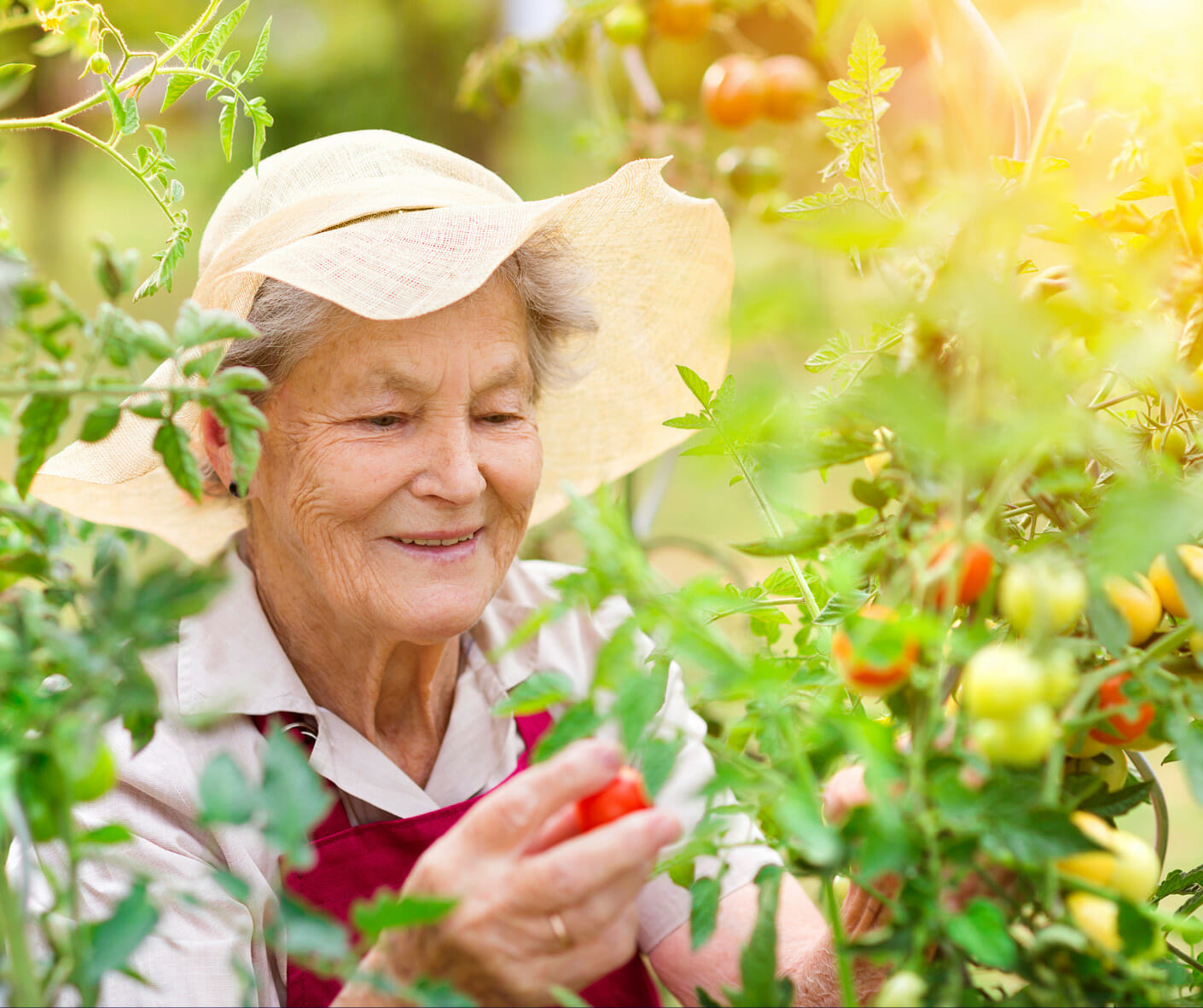Many studies over several decades have shown the value of gardening as therapy (1). Being outdoors in nature, spending time in gardens, and working with plants has mental, physical, social, and emotional benefits for seniors. Older adults are unfortunately more at risk of physical and mental illnesses. So, gardening can be even more beneficial for seniors! Gardening is a great form of therapy for seniors. Gardening can be a fun and rewarding hobby, help cultivate wellness, and even treat and prevent illness.
The Power of Gardening
Did you know that gardening can improve your sleep, lower your body mass index, increase your hope and happiness, and reduce symptoms of stress, depression, and anxiety? It’s true! (2) Research has demonstrated the incredible power of gardening. As you spend time in natural spaces, you’ll notice your stress decrease and your sense of life satisfaction and happiness increase. Creating a garden gives you a chance to spend time in nature, while also providing opportunities for movement and physical activity. On top of all these benefits, growing your own food and flowers is both good for your health and incredibly rewarding.
Gardening can also be a good social activity. To get these social benefits, you can join local gardening groups, take classes, and participate in community gardens. This increased social connection is important for seniors and retired people who may experience feelings of isolation and loneliness.
Cultivating Wellness
When you think of your best, most enjoyable life, what words come to mind? Most seniors want to feel calm, joyful, fulfilled, and satisfied. Gardening can actually help you achieve all of these goals! Connecting through nature is incredibly fulfilling and satisfying. One Japanese study showed that viewing plants actually reduced stress, fear, anger and sadness, as well as reducing blood pressure, pulse rate and muscle tension. These benefits will help you experience a feeling of calm wellness that will improve all areas of your life.
Beginning Gardeners
For many seniors, starting a garden can feel like an impossible task. Older people may face physical challenges when it comes to gardening. For example, stiff joints and back pain can make bending over to work with plants on ground level painful. Arthritis can make it difficult to use garden tools. Fatigue is another barrier many seniors face.
Thankfully, gardening doesn’t have to be excessively painful or challenging! Modifications can be made to make it accessible for anyone. For example, try starting a square foot garden in raised planter boxes. Buying taller planter boxes at standing height will alleviate joint and back pain. With just a few small boxes, you can grow a surprising amount of food, herbs, or flowers. For arthritic hands, try ergonomic garden tools.
If you are lacking the space or time for an outdoor garden, you can experience a lot of benefits from a few indoor plants. Pot some devil’s ivy or a snake plant in a windowsill, and you’ll see that gardening doesn’t have to be hard or expensive. You could also join a community garden in your neighborhood or senior living community and enjoy taking care of plants with the help of others.
Getting Started with Outdoor Gardening
As you get started with gardening, you’ll need a few tools. Here are our suggestions for gardeners with outdoor space. These tools are ergonomic, which is helpful for seniors with stiff or swollen joints or arthritis.
- Lightweight hand trowel. This one is a great size for potting all types of indoor and outdoor plants, in the ground or in planters.
- Garden claw. If you’re gardening outdoors with in-ground plants, get a claw tool that will allow you to weed or dig up beds without bending over.
- Automatic hose reel. For outdoor gardeners with more space, invest in a great hose reel. This will prevent you having to drag a large heavy hose all over the place when watering.
- Long-reach garden tools. These long-reach tools are great for seniors who want to sit on a stool or chair while gardening.
- Elevated garden beds. A counter-height garden bed, like this one, will mean you can garden without needing to bend over at all.
- Leather gardening gloves. Heavy-duty waterproof gloves will allow you to keep your hands clean and protected while gardening. Check out this cute floral option.
- Soil. If you are beginning a large garden, you’ll need to purchase some bulk soil. In the spring, most big box stores and hardware stores sell bags of soil. You will do best with soil that contains compost, or outdoor potting soil. We’ve had the best success with Miracle-Gro brand soil, which eliminates the need for fertilizer in the first year. Bags sold as “topsoil” or “all purpose soil” won’t have many nutrients, so you’ll need to make sure to purchase fertilizer as well if using these.
With an outdoor garden, you can start plants from seed or buy starter plants. If starting from seed, check the seed labels to see when to plant and if the plants need to be started indoors. If they do, you’ll also need the items from our indoor gardening guide. Starting plants from seed can be extra rewarding and educational, but it typically isn’t less expensive unless you want many plants of the same variety. It also takes much longer. For beginners, we recommend purchasing small plants from your local garden center in the spring.
Indoor Gardening Guide
You don’t need a lot of outdoor space to be able to get all the benefits of gardening. Here are our suggested tools for beginning an indoor garden.
- Indoor planters. These planters come in an infinite variety of shapes, sizes, and colors. They’re available at any big-box store, garden store, hardware store, or online. Choose colors and styles that compliment your interior decor. Since most indoor plants require some sunlight, it’s a good idea to choose planters that will fit on your window sills. Sills are typically 4-6 inches wide, so choosing 4 inch planters is a safe bet. You can also use hanging planters for plants that like to drape.
- Indoor potting soil. Using a soil formulated for indoor plants will cut down on pests and overwatering/underwatering issues. For beginners, we recommend Miracle-Gro Moisture Control Indoor Potting Soil.
- A small, lightweight trowel. Most indoor gardening can be done using just your hands, but a light ergonomic trowel can be helpful.
Indoor plants can also be started from seed or purchased. It’s usually easiest to purchase small, healthy plants and give them room to grow.
Plant Suggestions
When choosing plants, keep in mind a few considerations.
- For outdoor plants, know your zone. Your address will help you determine which planting zone you’re located in. Make sure to buy plants labeled for your zone, or your plants will be unable to survive your climate. Note: if your plants will be indoors only, you don’t need to worry about which zone you are in.
- Sunlight. Some plants require more sunlight than others. For example, hydrangeas prefer morning sun and afternoon shade in most zones. Sunflowers require full sun. Plants like ferns or impatiens do best in shady areas. Consider how much sun your plants will get when deciding where to plant and which plants to buy.
- Size. Plants come in a huge variety of shapes and sizes. Don’t plant a tree on a windowsill! Check plant labels to see how big they will get before deciding where to plant.
- Water requirements. Outdoor plants typically need to be watered daily during the growing season. Indoor plants can usually be watered around once a week. But each plant has its own water needs, so make sure you’ll be able to meet them.
Easiest Plants to Grow
Some plants are lower-maintenance than others. Here are the easiest outdoor plants for most climates.
- Tomatoes. In warm, dry climates, tomatoes often do well and grow easily. Be careful not to over-water them, or your tomatoes will split.
- Zucchini. One zucchini plant will usually produce a huge number of zucchini! They’re not prone to many diseases, but keep an eye out for squash bugs.
- Strawberries. Strawberry plants are a perennial that will come back year after year, and don’t require a lot of upkeep. Keep plants away from deer or other animals that may eat them before you can harvest.
- Marigolds. These are pretty low-maintenance outdoor flowers.
- Pansies. Pansies are very resilient and bloom well in spring and fall.
- Daffodils. Plant them once and they’ll come back every year! They require almost nothing from you once the bulbs are planted.
These are the easiest-to-grow indoor plants for beginners:
- Devil’s ivy (also called pothos). Pothos is very drought-tolerant, easy to propagate, and can thrive even without sunlight.
- Snake plants. These can go weeks without water and also don’t need a lot of light.
- Succulents. Since they don’t grow very large, succulents are great for small spaces and don’t need a lot of watering.
- Ferns. Ferns are beautiful hanging from a basket or potted on any surface. They’re also shade-tolerant and help purify air.
As you can see, gardening is a powerful therapy for seniors and a great tool for cultivating wellness. It’s a fairly easy and inexpensive hobby with so many physical, mental, emotional, and social benefits! Stellar Living hopes that this helps gardening to be a great therapy for you to cultivate wellness throughout your senior years.




